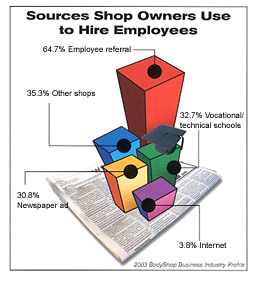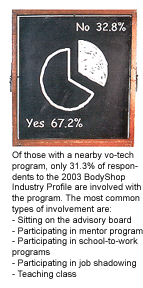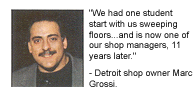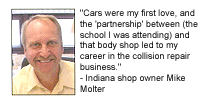Ring, ring, ring!
“ABC Tech Center Automotive Program, may I help you?” asks collision repair instructor Pat Peterson.
“Yes, this is Joe Smith at City Collision Center. I just had a tech quit today and have an opening. Send me your best student,” says shop manager Joe.
“Joe who?” asks Pat.
“Joe Smith, you remember me. I called two years ago the last time I needed a tech.”
“Oh, sure, Joe. I think I remember that. I’ll let my students know you’re hiring. Have a nice day,” says Pat.
Pat, who could be any instructor at any local vocational-technical school or community college, hangs up and goes about his business with his students, thinking: “Yeah right, Joe. The only time I ever hear from you is when you need people.
“The only shops that get my best students are those that partner with me year round, even when they aren’t hiring. My partners donate tools, paint, equipment, parts and fenders to my program, serve on my advisory committee, host open houses at their shops and come in and do demonstrations for my students here at school. Not to mention the fact that many of my former students are now working for these shops. Sorry Joe, but until you ‘get it,’ you won’t be ‘getting’ any of my students.”
This scenario happens practically every day across the country. Has it happened to you? Want to prevent it from happening?
If you’re serious about wanting to hire the best students, then you also need to get serious about partnering with local schools.
Evaluating Local Programs
In the United States, there are somewhere between 1,200 to 1,400 schools that offer collision repair training programs. The quality of these programs varies as much as the quality of some aftermarket parts. Some are very good, even ASE certified. Some are pretty good, some are mediocre and some are very poor – a waste of taxpayer dollars and everyone’s time.

ASE has a certification program for schools through its National Automotive Technicians Education Foundation (NATEF). It’s very hard to become certified, so the programs that have earned this ASE certification are very good. The instructors must be ASE certified, the curriculum must be up-to-date and the students must have access to appropriate tools and equipment.
If your local school’s program is ASE-certified, you know that the students have been exposed to a great deal of the industry and are ready for you to take them to the next level.
There are more than 328 ASE-certified collision repair schools in the United States – approximately 203 are at the high school level, 72 are at the community college/university level, one is a private school and 52 are providing both high-school-and-college-level training. To find out if there’s an ASE-certified school in your area, go to the NATEF Web site at www.natef.org.
What caliber of programs do you have in your area? As you consider this, you’ll want to have a list of questions like the ones below to help you evaluate local schools:
School Prospect List Assessment
– How far is the school from my shop(s)?
– Who’s the instructor?
– What’s the instructor’s background? Real-world experience? Is he/she ASE-certified?
– Is the program ASE-certified? If so, in what areas of concentration? If not, are there plans to seek certification?
– How well-equipped is the school’s shop? Does it have the tools and equipment necessary to teach students how to work on today’s cars?
– Does this program have the support of the school’s administration?
– What’s the program’s average annual enrollment?
– How many students does the program actually place in the industry? How many are still in the industry five years later? (If you can get an answer to that last question, let me know because almost no one does this kind of tracking.)
– Does the program follow a particular curriculum? If so, what does it look like and how current is it?
– Does the program participate in SkillsUSA (formerly known as VICA)?
– Who’s on the program’s advisory committee and what’s the role of the committee? Does it actually have an impact on the quality of the program?
– If the overall program isn’t particularly current, is there a willingness on behalf of the instructor and administrators to raise the relevancy of the training?
Let’s face it. Some school programs out there simply aren’t worth your time and effort. But you should at least explore the program to see if you can help them out. If, however, an instructor has tenure and couldn’t care less about the relevancy of the program, there isn’t really much you can do about it except let your feelings be known to administrators.
Partnering With a School
If you’re fortunate enough to have a good school in your area, there are certain things you can do to maximize your success in partnering with these schools.
- Partner year-round; you’ll have the best chance of hiring the best students.
- Serve on the program’s advisory committee and attend their meetings. Participate in these meetings by being vocal about the good things the program is doing and point out areas where the program can improve. Discuss what you’re willing to do to help the program improve.
- Constantly think about the school program before you throw away old parts, tools and equipment. Would the school benefit by having these items?
- Have some of your skilled people do demos for the students, either at the school or at your shop.
- Host an open house at your shop and invite administrators and parents to see what today’s collision repair industry is all about and what the opportunities are for those who seek a career in it.
On other hand, you may not have a decent school in your area. If that’s the case, you’re not alone. (Schools are filling only about 25 percent of our entry-level needs.)

If you find yourself in this situation, refer to the May 2002 issue of BodyShop Business on how to build your own successful in-house mentoring or apprenticeship program (go to www.bodyshopbusiness.com, search past issues of BSB using key word, “Claypool” and read the article, “May the (Work) Force Be with You”), or contact organizations
like Mentors At Work for help at www.mentorsatwork.com.
Even if you do have good schools in your area, it won’t hurt to use the above resources. After all, you’re still going to need to know how to teach a student (with basic skills learned in school) to become a fully functioning technician on his own or as a part of a team.
Real-World Examples
Obviously, the best-case scenario is to partner with a good school, if at all possible. These partnerships can be very successful.
To give you an idea of just how successful they can be, I spoke with several shop owners who know firsthand:
- Marco Grossi, owner, Collision Craftsmen, a group of shops in the Detroit area:
- Partners with local schools and hires students to work in his shops.”We had one student start with us sweeping floors, moved his way up and is now one of our shop managers, 11 years later,” says Grossi. “In 16 years in business, we’ve probably hired 15 students from school training programs. Most have left our employment but are still in the industry.”We trained them and prepared them to be full techs on their own, but volume of work doesn’t always allow us to give them all the work they want. Doing so would mean we’d have to take work away from our long-term techs, and we aren’t going to do that – so we lose them to someone else who can give them the volume they desire.”
Grossi’s had both positive and negative experiences with new hires from his school partners. On the negative side, Grossi says that many of the students enrolled in school training programs are there mainly to get out of going to regular classes. And this is true. The average class size at your typical school training program is 20 – and only about three to five of these students will actually enter our industry with the intent of making it a long-term career.

Grossi also points out that students can go to work at some fast food restaurants and start between $8 to $10 an hour, a figure that’s hard for a shop to justify for a new hire who produces very little work. However, looking at new hires as an investment needs to be the mindset – paying a little more up front in the hope that you’ll see a return on your investment.
If you have a system in place for taking these new hires from entry-level to skilled technicians, your chances for retention go up significantly.
- Mike Anderson, owner, Wagonworks Collision, Alexandria, Va.:
- Is involved with local schools and SkillsUSA (VICA).
- Serves on five school craft committees (same as advisory committees).
- Pays for a local school instructor to attend NACE each year.
- Sends a guest speaker from his shop to various schools each month, usually to do demonstrations or to talk about what certain positions in the shop do (i.e. what an estimator does).
- Hosts field trips for local schools, provides lunch, shows them around and lets them talk with employees.
- Speaks with local instructors and guidance counselors at every opportunity to educate them about the fact that our industry is looking for the brightest students – students who have good reading, writing and math skills. He also stresses the need to have typing skills and computer knowledge.”We, as prospective employers, need to educate the counselors as to our needs and desires since they’re the ones dictating which students enroll in the various programs,” says Anderson. “I try and be present the night of parent/teacher open houses so I can explain to parents what we have to offer in our industry.”
- Sponsors local SkillsUSA contests.
- Attends local career days.I mentioned earlier that some tenured instructors may have no desire to provide relevant training. Anderson doesn’t put up with that.”If I’m attempting to work with a specific teacher or program with no desire – for example, a teacher who’s just logging time until retirement – then I’ll call the school superintendent in a heartbeat,” says Anderson. “My tax dollars are paying part of his salary whether I have a student in his program or not, and who else has the knowledge to keep a teacher accountable other than someone in the industry? A principal of the school isn’t going to know without feedback.”With everything that Anderson is doing locally, what’s he getting out of it? How are the partnerships working for him?”Even though the vocational program is far from perfect, 12 of my current employees came out of a local program. That’s where the return on investment is,” he says. “It costs about $500 to run a help wanted ad, and turnover costs a lot. So invest your time and money into a local vocational program. You have much more control over how your money is used.
“Will all of the kids work out? Probably not. The ratio might only be 1 out of 20, but I’ll still take those odds over a newspaper ad or the same old bad-habit techs who might apply.”
Jack Lamborghini, Woburn Foreign Auto Body, Woburn, Mass.:>
- Has strong relationships with two schools in his area, describing one of the instructors as “dedicated to those kids” and the other as one who consistently “goes above and beyond.” Both, in his mind, take an extraordinary interest in their students. Lamborghini is fortunate to have two such schools in his area.
- Serves on the schools advisory committees.
- Opens his shop for tours.
- Speaks at classes.
- Attends parent/teacher nights.
- Mike Molter, owner, Twin City Collision Repair, Lafayette, Ind.:
- Works with the area vo-tech college by serving on the advisory committee and staying in contact with course instructors. “We currently have two technicians in our employ who were refereed to us at least in part because of that relationship,” says Molter.
- Works with area vo-tech college and with area high schools to provide tours and conferences with interested students to let them know about the opportunities available to them in the collision repair industry.

Molter, himself, was once a student in an auto training program – going to school in the morning and working in a body shop in the afternoon. This exposure helped Molter decide that this was indeed the field for him.”Cars were my first love, and the ‘partnership’ between my school and that body shop led to my career in the collision repair business,” says Molter, who later earned a business degree from Purdue University. “The collision repair business has been very good to my family and me.”What goes around comes around, so it was only right that when I got to the position where I could help others get started that I should do so.” - Hires technical college students. “We currently have a young man employed here who was studying auto mechanics [at a local technical college] and through the school, he contacted us about a part-time job,” says Molter. “He’s now full time and has been assigned to a body team and is gaining experience. We’re providing additional training through ASE, I-CAR and on-site. He’s a great kid and is doing a great job.”By putting him on a team with more experienced technicians, he’s had great exposure to the collision repair processes as well as constant supervision and support from his team members. … We hope that he stays with our company for many years and we believe he will.”I believe that if everyone would help educate these young people about the opportunities available in our industry and help them to get started, we’d all be better off.”
The Common Denominators
Shop owners who successfully work with schools:
– Serve on local school advisory committee(s) and help the program meet the training needs (tools, equipment, parts, etc.)
– Serve year-round, even if they don’t need people right now.
– Attend parent/teacher conferences.
– Participate in career fairs.
– Host open houses at their shop.
– Do presentations for students at the school.
– Give young people from these training programs a chance.
– Don’t expect 100 percent success. Fifty percent is more realistic.
– Establish mutual respect.
It’s Never Too Late
Ring … Ring … Ring!
“ABC Tech Center Automotive Program. May I help you?” asks collision repair instructor Pat Peterson.
“Hey Pat, this is Joe at City Collision Center. I called last week looking for one of your students to come and work for me,” says shop manager Joe Smith.
“Yes, Joe, I remember. Did anyone come and apply?” asks Pat, knowing the answer before asking the question.
“No, but maybe I’m at fault here Pat. I just read this article in BodyShop Business, and I think I’ve been kind of short-sighted. Do you have any room for more help on your advisory committee?” asks Joe.
“Hey,” thinks Pat, “Maybe he finally gets it.”
Writer Mark Claypool is president and CEO of Mentors At Work. Claypool is the former executive director of the National Auto Body Council and of the I-CAR Education Foundation and the former director of development for Skills USA/VICA.













